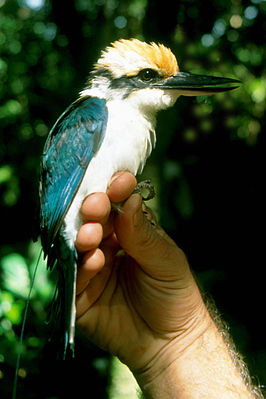Cinnamon heads
| Cinnamon heads | ||||||||||||
|---|---|---|---|---|---|---|---|---|---|---|---|---|

Zimtkopfliest ( Todiramphus cinnamominusreichenbachii ) |
||||||||||||
| Systematics | ||||||||||||
|
||||||||||||
| Scientific name | ||||||||||||
| Todiramphus cinnamominus | ||||||||||||
| ( Swainson , 1821) |

The cinnamon head ( Todiramphus cinnamominus ) is a representative of the kingfisher found in the Pacific region - genus Todiramphus .
features
The cinnamon head is about 20 cm long. It has a large, dark beak, a cinnamon-colored head, a dark eyeliner and blue-green upper wings. The two subspecies T. c. pelewensis and T. c. richbachii are characterized by a white throat and white undersides. In the two northern subspecies, the neck is cinnamon-colored. The males of the subspecies T. c. cinnamominus also have a cinnamon-colored breast and undersides of wings.
Occurrence
The distribution area of the Zimtkopfliest is limited to three archipelagos in the southwestern Pacific , on each of which a subspecies occurs. On a fourth group of islands, another subspecies died out at the beginning of the 20th century.
Hazard and protection
The Ryūkyū Liest ( T. c. Miyakoensis ) is only known from a single specimen that was collected on the Japanese Miyako Islands in 1887 , since then the subspecies has been lost. The Guam-Reads T. c. cinnamominus became extinct in the wild due to the introduction of the brown night tree snake ; There are populations in captivity, but reintroduction would only be possible if snake-free areas can be created. The holdings of T. c. richbachii on Pohnpei have decreased significantly for reasons that are not yet clear.
Subspecies
- T. c. cinnamominus ( Swainson 1821); subspecies found only on the island of Guam .
- T. c. pelewensis ( Wiglesworth 1891); endemic to the Palau Islands .
- T. c. reichbachii ( Hartlaub 1852); their distribution area includes the island of Pohnpei and the archipelago of the Karolinen .
- † T. c. miyakoensis or Todiramphus miyakoensis ( Kuroda 1919); this subspecies occurred on the Japanese Ryūkyū islands until the beginning of the 20th century . Some authors regard it as a distinct species.
Behavior and food
The Zimtkopfliest is a hide hunter . It feeds on soil insects , grasshoppers, and small reptiles .
literature
- C. Hilary Fry and Kathie Fry: Kingfishers, Bee-Eaters, & Rollers. Princeton, New Jersey 1992, 1999, ISBN 0-691-04879-7 .
Web links
- Todiramphus cinnamominus in the endangered Red List species the IUCN 2008. Posted by: BirdLife International, 2004. Retrieved on January 2 of 2009.